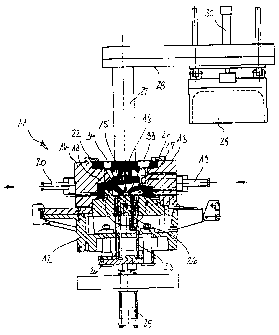Some of the information on this Web page has been provided by external sources. The Government of Canada is not responsible for the accuracy, reliability or currency of the information supplied by external sources. Users wishing to rely upon this information should consult directly with the source of the information. Content provided by external sources is not subject to official languages, privacy and accessibility requirements.
Any discrepancies in the text and image of the Claims and Abstract are due to differing posting times. Text of the Claims and Abstract are posted:
| (12) Patent: | (11) CA 2344237 |
|---|---|
| (54) English Title: | MOULD COMPRISING OUTER MOULD PARTS AND MOULDING MATERIAL CORES INSERTED INTO SAME |
| (54) French Title: | MOULE COMPRENANT LES PARTIES EXTERNES DU MOULE ET LES MATERIAUX DES NOYAUX DE MOULAGE INSERES DANS CE MEME MOULE |
| Status: | Expired and beyond the Period of Reversal |
| (51) International Patent Classification (IPC): |
|
|---|---|
| (72) Inventors : |
|
| (73) Owners : |
|
| (71) Applicants : |
|
| (74) Agent: | SMART & BIGGAR LP |
| (74) Associate agent: | |
| (45) Issued: | 2005-02-15 |
| (22) Filed Date: | 2001-04-18 |
| (41) Open to Public Inspection: | 2001-10-19 |
| Examination requested: | 2001-04-18 |
| Availability of licence: | N/A |
| Dedicated to the Public: | N/A |
| (25) Language of filing: | English |
| Patent Cooperation Treaty (PCT): | No |
|---|
| (30) Application Priority Data: | ||||||
|---|---|---|---|---|---|---|
|
A mould comprising outer mould parts and inserted moulding
material cores which, together, form a mould cavity, wherein
inner cores consisting of moulding material are arranged in
several layers one above the other and are clamped in between
the outer mould parts and a final covering core consisting of
mould material, with a continuous flow of force taking place
therebetween and wherein the mould cavity is formed by
surfaces of the outer mould and by surfaces of the inner cores
and of the covering core.
Note: Claims are shown in the official language in which they were submitted.
Note: Descriptions are shown in the official language in which they were submitted.

2024-08-01:As part of the Next Generation Patents (NGP) transition, the Canadian Patents Database (CPD) now contains a more detailed Event History, which replicates the Event Log of our new back-office solution.
Please note that "Inactive:" events refers to events no longer in use in our new back-office solution.
For a clearer understanding of the status of the application/patent presented on this page, the site Disclaimer , as well as the definitions for Patent , Event History , Maintenance Fee and Payment History should be consulted.
| Description | Date |
|---|---|
| Time Limit for Reversal Expired | 2009-04-20 |
| Letter Sent | 2008-04-18 |
| Inactive: IPC from MCD | 2006-03-12 |
| Inactive: IPC from MCD | 2006-03-12 |
| Inactive: IPC from MCD | 2006-03-12 |
| Grant by Issuance | 2005-02-15 |
| Inactive: Cover page published | 2005-02-14 |
| Pre-grant | 2004-12-02 |
| Inactive: Final fee received | 2004-12-02 |
| Notice of Allowance is Issued | 2004-07-21 |
| Letter Sent | 2004-07-21 |
| Notice of Allowance is Issued | 2004-07-21 |
| Inactive: Approved for allowance (AFA) | 2004-07-07 |
| Amendment Received - Voluntary Amendment | 2004-04-20 |
| Inactive: S.30(2) Rules - Examiner requisition | 2003-11-20 |
| Application Published (Open to Public Inspection) | 2001-10-19 |
| Inactive: Cover page published | 2001-10-18 |
| Letter Sent | 2001-08-15 |
| Inactive: Single transfer | 2001-07-06 |
| Inactive: First IPC assigned | 2001-07-04 |
| Inactive: IPC assigned | 2001-07-04 |
| Inactive: IPC assigned | 2001-07-04 |
| Inactive: Filing certificate - RFE (English) | 2001-05-23 |
| Inactive: Courtesy letter - Evidence | 2001-05-22 |
| Inactive: Filing certificate - RFE (English) | 2001-05-17 |
| Filing Requirements Determined Compliant | 2001-05-17 |
| Application Received - Regular National | 2001-05-17 |
| Request for Examination Requirements Determined Compliant | 2001-04-18 |
| All Requirements for Examination Determined Compliant | 2001-04-18 |
There is no abandonment history.
The last payment was received on 2004-03-23
Note : If the full payment has not been received on or before the date indicated, a further fee may be required which may be one of the following
Patent fees are adjusted on the 1st of January every year. The amounts above are the current amounts if received by December 31 of the current year.
Please refer to the CIPO
Patent Fees
web page to see all current fee amounts.
| Fee Type | Anniversary Year | Due Date | Paid Date |
|---|---|---|---|
| Application fee - standard | 2001-04-18 | ||
| Request for examination - standard | 2001-04-18 | ||
| Registration of a document | 2001-07-06 | ||
| MF (application, 2nd anniv.) - standard | 02 | 2003-04-18 | 2003-03-12 |
| MF (application, 3rd anniv.) - standard | 03 | 2004-04-19 | 2004-03-23 |
| Final fee - standard | 2004-12-02 | ||
| MF (patent, 4th anniv.) - standard | 2005-04-18 | 2005-03-22 | |
| MF (patent, 5th anniv.) - standard | 2006-04-18 | 2006-03-24 | |
| MF (patent, 6th anniv.) - standard | 2007-04-18 | 2007-03-26 |
Note: Records showing the ownership history in alphabetical order.
| Current Owners on Record |
|---|
| VAW MANDL & BERGER GMBH |
| Past Owners on Record |
|---|
| HORST BOHN |
| PETER WILLFORT |